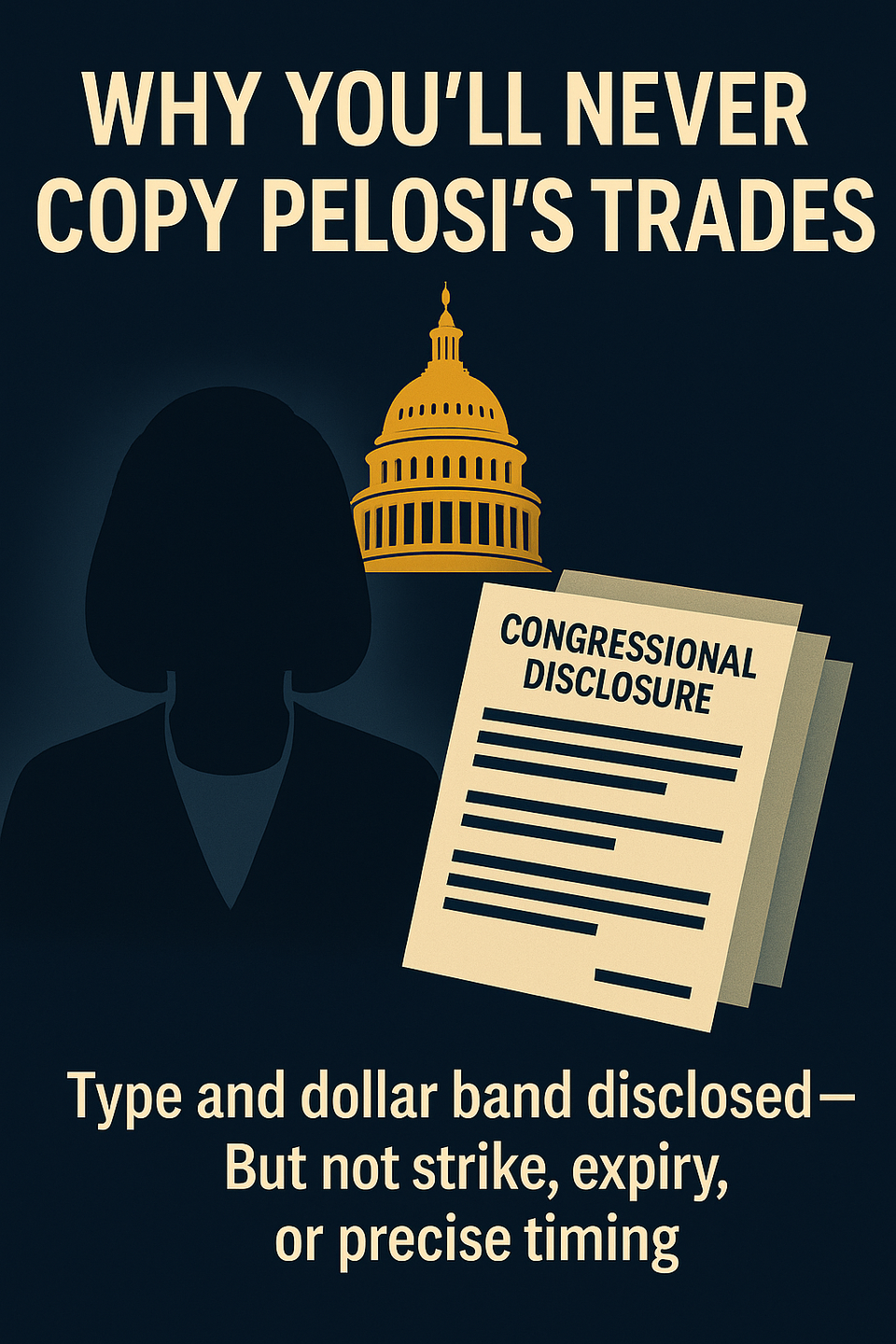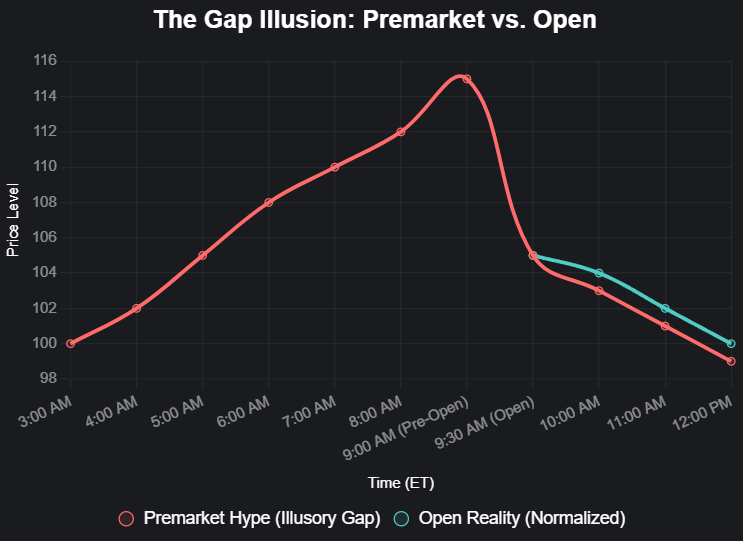Why You'll Never Copy Pelosi's Trades (And What to Do Instead)

Let's be real about something nobody wants to admit: copying Nancy Pelosi's stock trades is nearly impossible. Not because you don't have access to the same information, not because you don't have enough money, but because the strategy you think you're copying is far more complex than it appears.
The numbers tell a different story than the headlines suggest. According to Quiver Quantitative data as of September 2025, Pelosi has made 182 documented trades worth $164.21 million over her 38-year career, with a net worth of $267.19 million. When you dig into the actual disclosure data, you discover something that completely changes the game: most of her big winners aren't stock trades at all—they're options trades that you literally cannot replicate.
The options illusion
Options are contracts that give you the right to buy (call) or sell (put) a stock at a set price (strike price) by a certain date (expiration). Their value can swing dramatically compared to stocks, and they're the backbone of Pelosi's biggest wins.
Here's what nobody talks about: the majority of Pelosi's profitable trades are options contracts, not stock purchases. When the news reports "Pelosi bought NVIDIA," what actually happened is she bought call options with specific strike prices and expiration dates that aren't included in the public disclosure.
Look at her documented winning trades according to Quiver Quantitative: NVIDIA options that gained 1,172.51% (September 2022) and 936.79% (June 2022), Broadcom calls up 105.06% (June 2024), Tesla calls, Apple calls, Microsoft calls. These weren't stock purchases—they were leveraged bets with precise timing and specific contract terms.
When you see "Pelosi bought NVDA calls for $250,000–$500,000," you're missing the crucial information that congressional Personal Transaction Reports (PTRs) don't include: What strike price? What expiration date? What was the underlying stock price when she bought them?
By the time the disclosure hits (members must file PTRs within 30 days of awareness and no later than 45 days after the transaction per STOCK Act), those exact contracts are either much more expensive or completely worthless. You can't buy the same trade even if you wanted to.
Key point: Congressional PTRs disclose type + dollar band—not strike, expiry, or precise timing. You're copying outcomes, not trades.
"Want to build a real strategy? Get my Dividend, Growth, Income, and Value playbooks - but you'll need to subscribe first.
The stock substitution trap
This is where retail investors get destroyed. They see "Pelosi bought NVIDIA" and buy NVIDIA stock. She bought leveraged call options; you bought shares.
These are completely different investments with completely different risk profiles. Her $250,000 options position might control $2.5 million worth of stock with limited downside risk. Your $1,000 stock purchase gives you $1,000 of exposure with different risk characteristics entirely.
When NVIDIA moves up 20%, her calls might gain 200% while your stock gains 20%. When NVIDIA drops 10%, her calls might expire worthless while your stock is down 10%. You're not playing the same game.
The moving target problem
Most post-2023 "Pelosi" trades are flagged as Spouse's Trade (Paul Pelosi) under Nancy's filings.
Here's another layer that makes copying "Pelosi trades" nearly impossible: you don't even know who you're supposed to be copying anymore.
When you look at the historical trading data (supplemental context from MLQ.ai), a clear pattern emerges. From 2020 to 2022, most trades were directly attributed to Nancy Pelosi herself. She was buying NVIDIA, Tesla, Apple, and Disney in her own name. But starting in 2023, something changed.
Suddenly, most of the high-profile trades shifted to disclosures filed under Nancy Pelosi (CA-11) and often marked "Spouse's Trade (Paul Pelosi)." PTRs allow for "Spouse's Trade" designations. These don't reveal who actually made the decision.
"Disclosures list dollar bands, not strikes or expirations. Without those, you're not copying trades—you're copying shadows."
This creates a fundamental problem for retail investors trying to follow a consistent strategy. Are you following Nancy's investment decisions or Paul's? Did the actual decision-maker change, or just the reporting structure? Has the strategy evolved, or are you chasing two different approaches thinking they're the same?
When Reddit users celebrate copying "Pelosi's Broadcom trade," they're actually copying Paul Pelosi's execution of an unknown decision-making process. The disclosure system doesn't tell you who made the decision, when it was made, or how it fits into their overall strategy.
You're not just copying trades late—you're copying the wrong person's trades without knowing it.
The broader context
Beyond the practical barriers, some argue congressional trading raises ethical questions about access to privileged information. Even if Pelosi had insider knowledge, by the time disclosures land, the market has already priced it in. You gain nothing.
The exercise game you'll never see
Many of Pelosi's stock trades are the result of complex options strategies you never see in the disclosures.
When you buy a call option, you're purchasing the right to buy shares at a specific price before a certain date. When you sell a put option, you're agreeing to buy shares at a specific price if assigned. Both strategies can result in stock purchases that appear in disclosures without showing the options positioning behind them.
For example, if Pelosi sold Apple put options months ago with a $130 strike price when Apple was trading at $150, and Apple dropped to $125, she'd be forced to buy shares at $130—above the current market price but potentially below her original target. The disclosure shows a stock purchase, but not the put options strategy that generated income while setting up the stock acquisition.
Alternatively, if she bought Apple call options with a $130 strike when Apple was at $120, and Apple rose to $180, she could exercise those options to buy shares at $130 and immediately have a $50 per share profit. Again, the disclosure might show a stock purchase, but not the options contracts that made it profitable.
The key problem: you're seeing the end result of multi-step options strategies, not the strategies themselves. By the time a stock trade appears in disclosures, you've missed the options positioning that created the opportunity months earlier.
The timing trap gets worse
With stock trades, being 19 days late means you missed some gains. With options trades, being 19 days late can mean the difference between a 200% winner and a 100% loss.
Options expire. They have time decay. The value decreases as expiration approaches. They become worthless if the stock doesn't move the right direction by the right date. When Pelosi's Broadcom calls gained 105.06% in June 2024, that gain was tied to specific market conditions and timing that existed when she bought them, not when you found out about them weeks later.
The disclosure delay in action
The disclosure data (sourced from Quiver Quantitative's analysis of congressional filings as of September 2025) shows the timing problem clearly:
- AVGO—Traded Jun 20, 2025, filed Jul 9, 2025 (19-day delay), price already +33.48%.
- TEM (options)—Traded Jan 14, 2025, filed Jan 17, 2025 (3-day delay), +165.97% by disclosure.
That Reddit thread about tailing Pelosi trades proves the point perfectly. One user made money on Broadcom calls and celebrated the win, but other users immediately warned: "The tracker that tracks Pelosi is always a little bit late" and "politicians have up to 45 days to declare their positions so by the time you see it whatever info she's trading on will almost always be priced in."
Even retail investors who try this strategy are warning each other it doesn't work consistently.
The replication impossibility
Even if you had perfect timing, unlimited money, and instant disclosure, you still couldn't copy her strategy because the critical details aren't public. PTRs only include the security type (e.g., "call option") and broad dollar ranges ($250,001–$500,000). Options trading requires:
- Exact strike prices (not disclosed)
- Specific expiration dates (not disclosed)
- Entry timing (disclosed weeks later)
- Understanding of her exit strategy (not disclosed)
- Knowledge of how each trade fits into her broader portfolio (not disclosed)
- Exit timing & roll decisions (not disclosed)
The disclosure system tells you she bought "call options" but not the actionable details you'd need to make the same trade.
Addressing the counterargument
While platforms like Quiver Quantitative offer valuable insights into congressional trading patterns, the lack of specific options data and delayed disclosures means you're still at a significant disadvantage. Some investors might partially replicate trades with luck or skill, but the structural barriers make consistent success nearly impossible.
What you're actually doing
When you think you're "copying Pelosi's trades," you're actually:
- Buying stocks when she bought options
- Making trades weeks after her entry points
- Risking your own money without knowing her risk management
- Following a strategy that exists only in headlines, not reality
- Potentially copying the wrong person's trades entirely
You're not following her trades. You're following a simplified, delayed, incomplete version of something that can't be replicated.
What actually works instead
Instead of chasing congressional trades, focus on strategies you can actually execute:
Build these habits instead
Want to build a real strategy? Get my Dividend, Growth, Income, and Value playbooks - but you'll need to subscribe first."
Learn options properly—If you're drawn to the leverage aspect, learn how options actually work. Understand strike prices, expiration dates, and time decay. Start with paper trading before risking real money.
Use sector ETFs for broad exposure—Want exposure to tech stocks like NVIDIA without guessing specific trades? Consider sector ETFs like XLK (Tech), QQQ (Nasdaq-100), or SMH (Semiconductors) for chip stocks like NVIDIA and Broadcom. For healthcare plays, try XLV (Healthcare). These give you diversified exposure to the sectors Pelosi trades without trying to time individual stocks.
Develop a screening process—Create criteria for stock selection based on fundamentals, technicals, or both. Use free tools like Finviz or SEC EDGAR to screen for stocks with strong revenue growth or insider buying. Build a repeatable process instead of chasing headlines.
Practice position sizing—Determine how much of your portfolio you'll risk on any single trade. Pelosi can afford to lose $500K on Disney; you probably can't afford to lose $500.
Set entry and exit rules—Define when you'll buy, when you'll sell for a profit, and when you'll cut losses. Stick to the rules even when emotions tell you otherwise.
Track your performance—Keep records of what works and what doesn't. Review your trades quarterly to identify patterns and improve your process.
Start small and scale up—Master the basics with small positions before attempting complex strategies or larger bets.
The goal isn't to get rich quick—it's to build sustainable investing skills that compound over time.
The brutal truth? Retail investors have built a cottage industry around copying trades that cannot be copied. They're chasing a strategy that doesn't exist in the form they think it does.
Stop chasing the ghost of congressional trades. Start building a strategy based on information that's actually available to you and trades you can actually execute.
She's playing a private game with private rules. Stop chasing her shadow—build your own playbook.
Subscribe for your 4 investment playbooks (growth, income, dividend and value)
Data sources: Congressional financial disclosures via Quiver Quantitative (September 2025), supplemental context from MLQ.ai, retail investor discussions on Reddit
This analysis is for education, not investment advice. Options carry risk and can result in total loss.






Member discussion